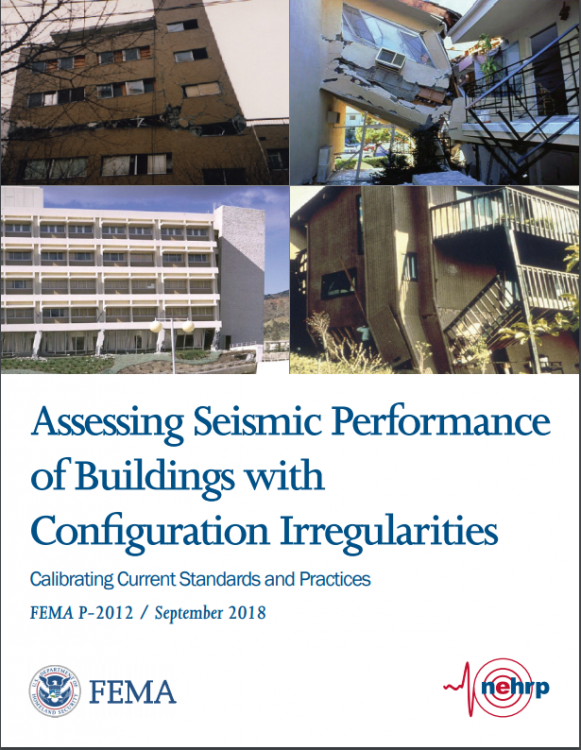-
Posts
1470 -
Joined
-
Last visited
-
Days Won
446
Content Type
Profiles
Forums
Events
Posts posted by UmarMakhzumi
-
-
FEMA P-2012/2018 Assessing Seismic Performance of Buildings with Configuration Irregularities is now available.
Thanks.
- Fatima Khalid, ILYAS, Howard Roark and 1 other
-
 2
2
-
 2
2
-
High water table (where the water is at or in close proximity to the base of foundation) would result in reduction of bearing capacity. Generally, geotechnical reports provide a factor to apply to bearing capacity values for such cases and the factor can vary from situation to situation. For example, on one project where I was working the geotechnical report directed to reduce the allowable foundation bearing pressure where water table is less than 1m below the foundation bearing grade. So, consult with your geotech and ask for the foundation bearing capacity reduction factor.
You can also look at the following link for more information:
Thanks.
-
On 3/15/2019 at 3:10 AM, Hazem said:
assalamu alaikum,,
I'm Hazem, an undergraduate student of civil engineering in Minya university (Egyptian university)
i'm glad to finally find such a wonderful forum full of topics i really need.
W.Salaam,
Hazem, welcome aboard. Glad to have you here.
Thanks.
-
Welcome aboard Atif.
Glad to have you here.
Thanks.
-
You can check the following resources too:
ISC_ExamI1&2&3 Composite Beams.pdfTopic -Composite beams.pdf
Links:
https://www.engr.mun.ca/~adluri/courses/steel/ppt files1/Topic -Composite beams.pdf
https://cee.umd.edu/~ccfu/ref/AISC_ExamI1&2&3.pdf
Thanks.
-
Hafsa,
Can you please explain what do you mean by composite beam as there are more than one ways to make a composite beam.
Thanks
-
Cables can take axial load only.
For difference between membrane and shell, there are a lot of existing discussion that you can look in the forum. Please use the search feature (on top right).
Thanks.
-
On 3/3/2019 at 3:37 AM, Mubeen Abid said:
1) Is GGBS enough to act as water proofing agent???
2) Can we cast concrete with GGBS under water without loss to durability???
Muneeb,
Before I reply the question, I just want to confirm that by water proofing did you mean water reducing? if yes, then GGBS can reduce the amount of water required to achieve given concrete strength. Anyway, if you didn't mean that then please see the response below.
Generally these questions should be refereed to the company providing the concrete mix design.
Ask the concrete mix design company (or ask your contractor to get this answer for you) if the mix design being provided have equivalent water proofing property) as that provided by the admixture. You can provide them the admixture data sheet so they can do they comparison and let you know.
I am not aware of any property of concrete that directly measures waterproofness. However, you might be able to establish co-relation if durability properties achieved are same with GGBS as with admixture.
Thanks.
-
-
On 3/1/2019 at 12:36 AM, Ahmad Ali AKbar Phambra said:
Dear Umar,
Thanks for your reply.I have looked into the topics you you shared but my question is not why need to reduce torsion constant to 0.01 or less!
My question is:
In my case, plinth beams showed zero torsional reinforcement (as you can see in the pics i attached in the post) but we have still provided the 2#4 longitudinal bars at the mid height for all plinth beams.So is it some minimum torsional reinforcement that we have to provide even if Torsional rft from ETABS comes about zero! What if in plinth beams we don't provide torsional rft at all will it still be safer?
Because in bachelor's i have never come across mid height rft concept and i am confused.If you can clarify my specific question that would be great!
I really appreciate your help!
Thanks
The question is answered because the discussions are about what kind of torsion a beam can experience and what to do when that happens. As per the discussion even for cases where there is compatibility torsion, even if you don't provide any reinforcement, the moment gets re-distributed. Considering that, for your case of plinth beam that has zero torsion in first place, providing additional just in case rebars aren't doing anything. There is no minimum torsional reinforcement that you have to provide. It should be clear from discussion on compatibility and equilibrium torsion.
Anyway, Canadian Code has a requirement for Skin Reinforcement for deep member. The requirement is to limit the formation of flexural cracks The requirement can be found in CSA A23.3-04. I can add some information there but it is not related to torsion and would be off topic. Similarly, ACI requires skin reinforcement on the tension half of beams greater than 36" deep. See 10.6.7 in ACI 318-02.
On the same, professional engineers can do anything if their “judgement justifies” that. From diagonal Renata at slab ends to double meshed (full top and bottom reinforcement) on slabs to counter shrinkage, to crazy masonry detailing are things you will notice. None of this is wrong as long as it can be justified.
Thanks.
-
8 hours ago, Abdallah Hassan said:
Thank you for reply
the solved examples in design guide is only for design base subject to uniaxial moment and axial force only, and I am looking for design base subject to N,Mx,My
If the moment in minor axis isn't big, you can find the resultant moment using square root of sum of squares and then use the AISC Design Guide 1 example. What structural member are you using for column? Is it HSS or W?
Thanks.
-
-
Ahmad,
There are a number of topics discussed that you can refer to on this topic. Try the following:
Thanks.
-
33 minutes ago, Saiful Islam Zaber said:
As there are two type of shell in Etabs - horizontal and Vertical ( Slab and Wall ) , Modelling the simply supported Beam by Slab Shell shows 216 kip-ft moment which is correct but Wall type shows 138 kip-ft which is not expected.
I am not aware of the difference.
33 minutes ago, Saiful Islam Zaber said:How should I model Deep Beam or swimming pool hanging from a large depth beam (but not Deep beam) bottom, as Slab or Wall?"
You can model a beam/ deep beam using beam elements and then mode the swimming pool as slab?
Let me know what you think. The picture above isn't clear. If you can explain what the framing and intent is, that would be great.
Thanks.
-
There are solved examples in Design Guide 1: Base Plate and Anchor Rod Design (Second Edition) | American Institute of Steel Construction. https://www.aisc.org/Design-Guide-1-Base-Plate-and-Anchor-Rod-Design-Second-Edition#.XG7vylxKiUk
You can also check your steel handbook or textbook for examples.
Thanks.
-
13 hours ago, kjjosafat said:
It is 1800rpm with 400kw/500kva/536hp, 60hz.
Is there any mechanical code regarding machine foundation?
These gensets aren't small. If vendor/ manufacturer suggests isolation pads, then you need to only worry about static design. Which is, the slabs on which these gensets are supported should be able to take the load. If that is not the case, and to answer your question about code regarding machine foundation, the document is:
Quote351.3R-04: Foundations for Dynamic Equipment (Reapproved 2011)
Now, if you have to do a dynamic design, the design would be somewhat complicated as the machine is located on 3rd floor of the building. I would advise going through the following threads to grasp an understanding of the fundamentals and then ask any questions that you may have.
Regarding the calculation provided by mjnasir:
On 2/19/2019 at 6:30 AM, mjnasar said:(3x14.78x1.2+ 0.2*24*9.38*4.215) / (9.38x4.215) = 6.14 Kn/m2
The weight of each genset is 1478 kg, which is equal to 14.78 kN. Basically, he has added all the 3 gensets and considered the foundation pad (0.2m x 9.38m x 4.215) weight (assuming this foundation pad would support all 3 gensets). He has calculated the total weight of gensets and foundation pad on existing slab and divided by the area of slab. This is correct for static design as long as your slab can meet the strength and serviceability requirements under this new load and any existing load.
Hope this helps.
Thanks.
-
Saiful Islam,
I like your curiosity and your question is good too. Generally for beams, if you wan to do 3-D modelling, solid elements should be used.The definition below would help you understand the difference:
QuoteShell elements are used to model structural elements in which two dimensions are much greater than the third one and when the change of the analysed feature across this third direction can be neglected. It is reasonable for static analysis of panel/planar elements such as slabs or walls as well as thin-walled spatial elements such as shells. The advantages of the use of shell elements, as you said, results mainly from time-saving due to reduced number of finite elements (and consequently the equations to solve). So, anytime you can reduce the problem to planar problem and neglect what happens at the thickness of the element I don't see the reason to use solid elements.
The results from the following simple analysis: http://www.javelin-tech.com/blog/2012/10/shell-vs-solid-elements/ suggest that it is when the third dimension is at least 20 times smaller than the other ones.
However, if the change of the analysed feature is on a comparable level in all directions of the analysed element, solid elements should be used. It is the case e.g. in block elements, like massive concrete elements which are among my interests. In such elements, the observed thermal and moisture fields are highly non-stationary and the resulting thermal and moisture gradients lead to formation of the internal restraint in the elements which, in turn, is the origin of (self-induced) stresses in the element. If that fact was neglected, we would not be able to analyse this phenomenon.



To simplify, shells elements are best for walls, slabs and modelling 3D elements where the thickness is smaller like surface elements.
Hope this helps.
Thanks.
-
On 2/17/2019 at 11:34 PM, kjjosafat said:
i have 3 generator sets with wet weight of 1478kg each. foundation pad is 0.2m x 9.38m x 4.215x respectively. it is installed in genset room at 3rd floor of a building with 4000psi slab density. do you have any equation for genset foundation design, when the foundation is to be installed in an existing floor slab? or how can i calculate if the genset pad is safe in that 4000 psi slab. thank you. hoping for your response
For gensets, generally vibration pads are extensively used to isolate the machine from the pad assuming they are small (what categorizes as small is another discussion). These pads are generally provided with the gensets. Your mechanical engineer should review those. The only thing to look there is if the pads cater for the operating rpm/ frequency of gensets.
Out of curiosity, what is the rpm and the horse power of the gensets that you are working on?
Thanks.
-
5 hours ago, Zain Saeed said:
Its looks a bit strange. Actually i have been using the story forces from ETABS summary report and not the Story shears for finding this story stiffness thing. It would be better if you can elaborate it with some example to clarify my thoughts. I have the understanding the as we are taking the absolute floor displacement and not the story displacement in the stiffness calculation and this displacement should be because of the story force and not the story shear which is sum of forces coming from all above stories
On 1/7/2013 at 1:22 PM, UmarMakhzumi said:Story Shear/ Story displacement
Shear is generally resultant for force at a given point. Like beam shear is sum of all forces at a section.
Similarly Story Shear refers to the net lateral load at a floor. ETABS might be defining story forces as net forces at a level and story shears as individual seismic shear for each floor (the opposite way). They can define it how they want, as long as they are referring to the same concept.
Displacement has to be absolute as we are interested in stiffness. If you were interested in any serviceability limit state, then it could be relative for that limit state. But for stiffness, its absolute to base.
Thanks.
-
9 hours ago, Zain Saeed said:
Umar bhae shouldn't be it story forces instead of Story shears ??? and the denominator as absolute maximum displacement of floors.
You have raised a good point. Generally stiffness is applied force/ displacement for force required for a unit displacement.
For seismic or any lateral loads, the loads sum up as you go from top to bottom. For for top floor, the stiffness is:
Force at top floor/ displacement
However, for the level below, the stiffness would be:
Sum of Top Floor and level below lateral forces / displacement of that level.

Let me know if this is still not clear and I can provide another example.
Cheers!
-
-
-
The attachment is very interesting and elaborate. Thanks for sharing that. I think you should go with the recommended iterations suggested by the vendor in the attachment. Start with an assumed U value and work your way to see if you meet the requirements. I would personally not worry about even considering the ductility of the structure when dampers are being used as ductility difference is significant.
On 1/31/2019 at 7:46 PM, Nustian371 said:Is there any way that you can check this in ETABS model at the end of analysis rather than calcualting from the damper properties or the supplier values
I am not aware but I would suggest going with the vendor suggested method as you are using a market product and adopting a different approach from what is recommended might end you up in liability issues if things go south.
Thanks.
-
W/Salaam,
Check these out Fatima:
http://docs.csiamerica.com/manuals/etabs/Software Verification.pdf
http://docs.csiamerica.com/manuals/sap2000/Verification/Title Page and Contents.pdf
You can also find these manuals in the installation directory of ETABS and SAP2000, that is where I first saw them.
Thanks.



I am Asif
in Member Introduction
Posted
Hi Asif,
Glad to have you on the forum. Welcome aboard.
Thanks.